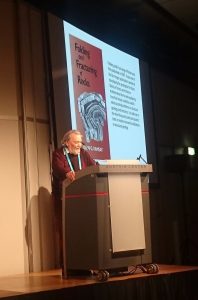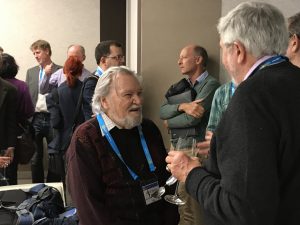
John G. Ramsay1 wrote his seminal textbook on the folding and fracturing of rocks in 1957, almost 20 years before I was born (and I don’t count myself as young!). So why did I co-convene a session at EGU in 2017 to celebrate the book? Because the book, in many ways, expresses the legacy that John has given to structural geology. He followed it with a series of books of the same ilk – Ramsay and Huber ‘The Techniques of Modern Structural Geology’, published in two volumes (1984 and 1987), was a main stay for me as an undergraduate and postgraduate and well actually now; although, it is often not to be found on my bookshelf, but on the desk of one of my graduate students. The Techniques of Modern Structural Geology, like the Folding and Fracturing of Rocks, is beautifully illustrated and describes geometrically and mathematically many of the now commonly used techniques in structural geology. So to me Ramsay, although I did not know him personally, was the name behind this interesting subject structural geology.

John Ramsay opening the session on his book “Folding and Fracturing of Rocks”. Credit: Susanne Buiter
It was as a postgraduate student that I met John at a Tectonic Studies Group (TSG) meeting and had the pleasure of dancing with him after the conference dinner! Many years on I am now the Chair of TSG, one of several specialist groups affiliated to the Geological Society of London. John was instrumental in founding TSG in 1970 @TSG_since1970 , when he was working at Imperial College London. As the Chair of TSG I was approached by several people enquiring about plans to celebrate 50 years since the publication of the Folding and Fracturing of Rocks. Given John’s European career and global impact EGU seemed the place to celebrate and I contacted some of John’s PhD students and collaborators to join me in convening a session to celebrate the book, John and structural geology.
Early on the morning of April 25th John gave the opening paper for the session to a large audience. He spoke not to a series of power point slides but to the audience about the book, his interests and his life as a structural geologist. I think one of the key messages for me is the one that he ended his paper with; that fieldwork is fundamental to structural geology and models need to be derived from and tested against field observations. John was followed by a series of speakers from Rod Graham, of Ramsay and Graham (1970)2 on shear zones from the field to seismic interpretation, to Richard Lisle (co-author with John on the third volume in the Techniques of Modern Structural Geology series)3. Richard gave an overview of the citations for the Folding and Fracturing of Rocks; it is the most cited structural geology textbook. Further papers were given in the afternoon poster session, celebrating and giving modern, and old, twists on aspects of the book.

Afterwards at the reception. Credit: Susanne Buiter
John joined many well-wishers at a reception and dinner after the session. John has given a legacy to structural geology, through his focus on the geometry and mathematics of structures backed up with detailed field observations, work that very much forms part of modern structural geology today.
The Folding and Fracturing of Rocks is currently published by Blackburn press.
Click here to go to the webpage of EGU Session TS1.3.
Blog by Clare Bond,
University of Aberdeen
Thanks to TecTask and TSG for sponsorship
1.John was born in 1931 in London, he was educated at Imperial College, London gaining a first class degree in 1952 and a PhD, working on superposed folds at Loch Monar Scotland. After military service he returned to the staff at Imperial, before taking up Professorial positions at the University of Leeds and the ETH in Zurich. He has been recognized for his work in advancing structural geology with many awards: Bigsby (1973) and Wollaston (1986) medals of the Geological Society of London, the Société Géologique de France Prestwich Medal in 1989, Sir Arthur Holmes Medal of the European Union of Geosciences (EGU) in 1984, C. T. Clough medal (1962) of the Geological Society of Scotland, the University of Liège medal in 1988. In 1992 he was named a Commander of the Most Excellent Order of the British Empire in the Queen’s Honours list. He is a Fellow of the Royal Society(elected 1973), and holds Honorary Fellowships of the Geological Society of America, the Société Géologique de France, the Indian National Science Academy, the American Geophysical Union, the US National Academy of Sciences and the Geological Society of London.
2.Ramsay, J.G. and Graham, R.H., 1970. Strain variation in shear belts. Canadian Journal of Earth Sciences, 7(3), pp.786-813.
3.Ramsay, J.G. and Lisle, R.J., 2000. The techniques of modern structural geology. Volume 3: Applications of continuum mechanics in structural geology. Academic, San Diego, Calif.



